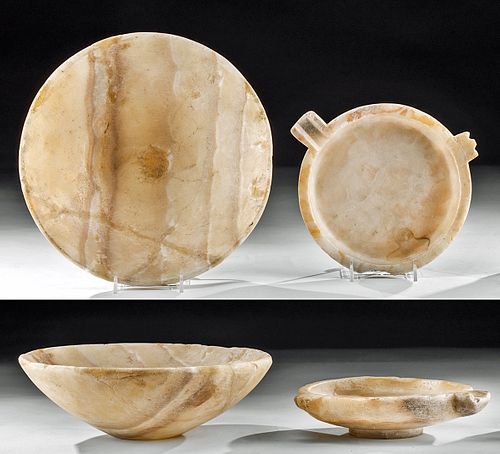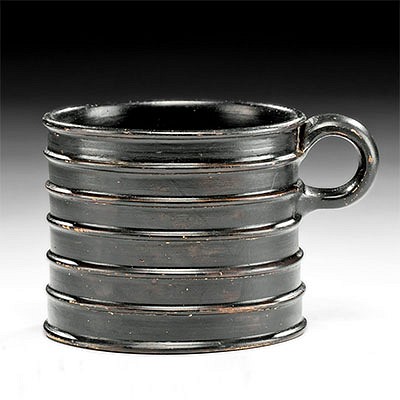Lot of 2 Large Bactrian Alabaster Offering Dishes
Lot 77a
About Seller
Artemis Fine Arts
686 S Taylor Ave, Ste 106
Louisville, CO 80027
United States
Selling antiquities, ancient and ethnographic art online since 1993, Artemis Gallery specializes in Classical Antiquities (Egyptian, Greek, Roman, Near Eastern), Asian, Pre-Columbian, African / Tribal / Oceanographic art. Our extensive inventory includes pottery, stone, metal, wood, glass and textil...Read more
Categories
Estimate:
$1,200 - $1,800
Absentee vs Live bid
Two ways to bid:
- Leave a max absentee bid and the platform will bid on your behalf up to your maximum bid during the live auction.
- Bid live during the auction and your bids will be submitted real-time to the auctioneer.
Bid Increments
| Price | Bid Increment |
|---|---|
| $0 | $25 |
| $300 | $50 |
| $1,000 | $100 |
| $2,000 | $250 |
| $5,000 | $500 |
| $10,000 | $1,000 |
| $20,000 | $2,500 |
| $50,000 | $5,000 |
| $100,000 | $10,000 |
| $200,000 | $20,000 |
About Auction
By Artemis Fine Arts
Mar 12, 2020
Set Reminder
2020-03-12 10:00:00
2020-03-12 10:00:00
America/New_York
Bidsquare
Bidsquare : Ancient / Ethnographic Around The World
https://www.bidsquare.com/auctions/artemis-gallery/ancient-ethnographic-around-the-world-4957
Ancient art from Egypt, Greece, Italy and the Near East, as well as Asian, Fossils, Pre-Columbian, Native American, African / Tribal / Oceanic, Spanish Colonial, Russian Icons, Fine art, much more! Artemis Fine Arts info@artemisfinearts.com
Ancient art from Egypt, Greece, Italy and the Near East, as well as Asian, Fossils, Pre-Columbian, Native American, African / Tribal / Oceanic, Spanish Colonial, Russian Icons, Fine art, much more! Artemis Fine Arts info@artemisfinearts.com
- Lot Description
Ancient Central Asia, Bactrian, ca. 3rd to 2nd millennium BCE. A pair of complementary alabaster offering dishes. The larger is a shallow bowl with a small, rounded but stable base and thin walls that allow natural bands of citrine, beige, and grey hues to illuminate when held to a bright light. It has a shallow basin and walls that flare outward to an unpronounced rim. The second is a very shallow offering dish standing on a raised disc foot and featuring a projecting spout on one side and a short handle with a decorative form at a ninety degree angle to the spout. Size of the larger: 10.25" W x 3.4" H (26 cm x 8.6 cm)
Alabaster, a light-colored, calcareous stone found on the Iranian Plateau, has strong connections in ancient western and central Asia to religion and specifically the gods. For example, in the site of Kultepe-Kanes, a huge burial mound, there were many disc-shaped alabaster idols, naked alabaster goddesses, and lion figures. We also know that alabaster was a precious material, widely traded in the region from the 4th millennium BCE onward. Dishes like these were made to be placed into a tomb to hold offerings.
Provenance: ex-Khan family collection, New Jersey, USA, 1980s
All items legal to buy/sell under U.S. Statute covering cultural patrimony Code 2600, CHAPTER 14, and are guaranteed to be as described or your money back.
A Certificate of Authenticity will accompany all winning bids.
We ship worldwide and handle all shipping in-house for your convenience.
#152922The larger of the two has been repaired from multiple large pieces; this is well done and unobtrusive, with small lines of visible adhesive along the repair lines. The other has a chip from one side and smaller chips from the spout and handle but is overall in very nice condition. Both have light deposits on their surfaces.Condition
- Shipping Info
-
All shipping is handled in-house for your convenience. Your invoice from Artemis Gallery will include shipping calculation instructions. If in doubt, please inquire BEFORE bidding for estimated shipping costs for individual items.
-
- Buyer's Premium



 EUR
EUR CAD
CAD AUD
AUD GBP
GBP MXN
MXN HKD
HKD CNY
CNY MYR
MYR SEK
SEK SGD
SGD CHF
CHF THB
THB

















